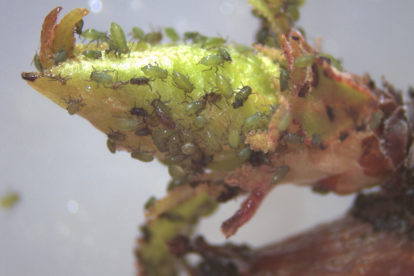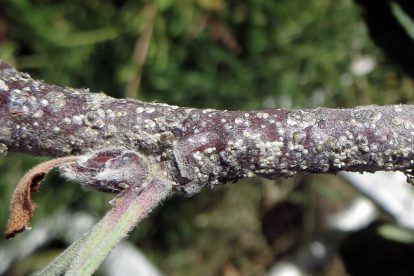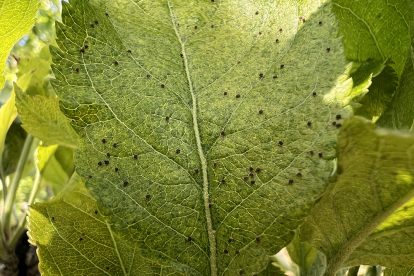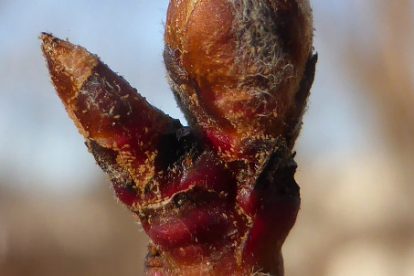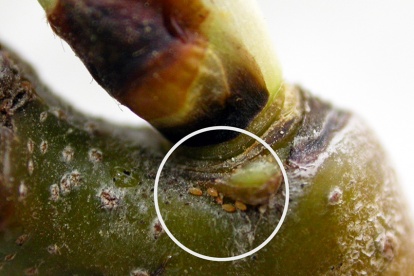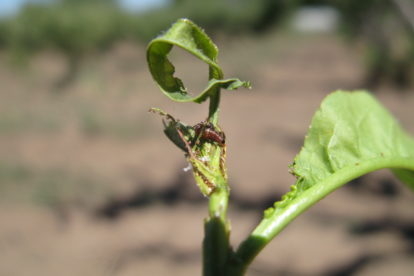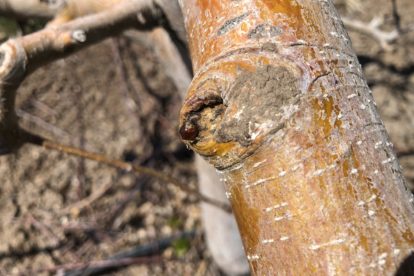In this Issue
- What Insects and Diseases are Affected by Oil or Copper Spray?
- Dormant Oil Spray – apply before bloom
- Copper Spray Options – for fire blight and peach leaf curl
- Grasshopper Update
- Pear Fruit Sawfly – controlled with insecticide before bloom
Insects and Diseases Affected by an Oil or Copper Spray
Click on an image for caption information.
Dormant oil does not control: codling moth, spider mites, borers, cherry fruit fly, powdery mildew.
Dormant Oil Spray Details
The “dormant oil” spray is applied after trees break dormancy. And in northern Utah, this is happening sooner than usual this year! Apricots buds are bursting, and apples in some places are starting to show some green. This means that now is a good time to apply, or to make preparations for, your application. There is still a window for most fruit trees up through mid-April.
The reason to wait for bud swell to apply the oil is because this timing coincides with increasing activity of the overwintering insect stages, such as the hatching of aphid eggs, scale nymphs starting to feed, and peach twig borer larval feeding. If applied too early, the oil will not work as well on these pests.
In the warmest areas of Utah, trees are blooming or past bloom, so the oil may already have been applied.
Should I Spray at All?
If your fruit trees have not been affected in the past by the pests in the image gallery shown above, you can skip the oil application.
When Should I Spray?
There are two factors to consider for determining when to spray: the bud stage of your own fruit trees and weather conditions.
Bud Stages
The window for application extends from bud swell to pre-bloom, usually a period of several weeks, depending on the tree.
Make your application between now and the last point at which you can safely apply oil (at the recommended rate below):
- apricot: first white to first bloom
- apple: half-inch green (ideally, application is made at green tip stage)
- cherry: white bud
- pear: green cluster
- peach/nectarine: just before first bloom (when the pink shows through the flower bud)
- plum: green cluster
Weather Conditions
- Only apply oil if temperatures remain above freezing (ideally above 40°F) for 12 to 24 hours after application.
- Ideally, oil should be applied on a clear, non-windy day in the 50° to 70°F temperature range.
- Do not apply if rain is predicted within 24 hours. This will help give the oil time to work.
- If rain is predicted farther out than 24 hours, then you are OK to spray.
How to Spray
Commercial growers
- Oil should be applied at a rate of 2-3%, which is 2-3 gallons per 100 gallons of water.
- (Optional) Mix oil with an insecticide such as Warrior or Asana to help improve knockdown of overwintering pests.
- When spraying apple or pear trees, it is OK to mix in copper for fire blight.
- Thoroughly cover all cracks and crevices of the tree bark and buds.
Backyard growers
- Oil should be applied at a rate of 2%, which is 5 Tbs in 1 gallon of water.
- If you are not growing organically, and aphids or scale have been a serious problem and oil alone has not worked in past years, consider mixing the oil with the appropriate rate of an insecticide, such as Spectracide Triazicide, GardenTech Sevin, or Malathion.
- When spraying apple or pear trees, it is OK to also mix in the proper rate of copper to help prevent fire blight bacteria from multiplying.
- Make sure you thoroughly cover all cracks and crevices of the bark and buds.
More details about oil
- Oil is sold as a concentrate, so it must be mixed at the proper rate with water before application.
- There are plant-based oils and petroleum-based oils. For the dormant oil application, the petroleum-based oils work the best, although canola-based oil is another option.
- Petroleum-based oils – There are many brands, and they all work the same. Examples include All Seasons Horticultural Oil, Monterey Horticultural Oil, Gordon’s Dormant Oil Spray, Ortho Volk Spray Oil, Hi Yield Dormant Oil, etc.
- Plant-based oils – One example is Natria Multi-Insect Control (canola oil), but there are many others. Neem oil is not as an effective option for the dormant application.
Dormant Copper Products
In Utah, copper can be used on apple and pear as a management tool for fire blight, or on peach/nectarine to help prevent peach leaf curl.
| Ingredient | Commercial Options | Residential Options | Comments |
|---|---|---|---|
| basic copper sulfate | Cuprofix Ultra Disperss; Basic Copper Sulfate; C-O-C-S | Effective, but should only be used before leaf emergence or in the fall | |
| copper oxide | Nordox | ||
| copper hydroxide | Kocide; Champ; Badge SC; NuCop; Previsto | Previsto has a low copper concentration | |
| copper diammonia diacetate complex | Monterey Liqui-Cop | ||
| copper octanoate (soap) | Cueva | Gardens Alive Soap Shield; Bonide Liquid Copper Fungicide; Natural Guard Copper Spray; Espoma Copper Soap | Has lower metallic copper concentration; safer on plants; effective |
| copper sulfate pentahydrate | MasterCop; Phyton | Not as effective as a dormant application. | |
Grasshoppers
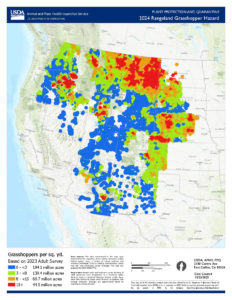
USDA just released their grasshopper outbreak risk map for rangeland in the West, showing that outbreak predictions for Utah are not nearly as bad as some other states, such as Montana. The risk level is shown as colors, with blue covering much of Utah, representing a density of 0 to 3 per square yard. The far northern part of the state is predicted to have higher populations.
However in 2023, grasshopper populations were high in Utah’s residential and city settings, and this map does not reflect those populations. We expect that urban populations will be similarly high in 2024. Please note that this could change if weather conditions during egg hatch are not favorable (cold and rainy).
The other bad news is that the best options for treating grasshoppers – baits – are in short supply. In fact, the company that manufacturers NOLO Bait (M & R Durango, Inc.) is not likely to have product in 2024. The other bait that is effective is EcoBran, and stock appears to be sold out across many online sites. If you search hard enough, you might find 44 lb bags, and you could go in with neighbors.
The timing for grasshopper control is at egg hatch (around mid-May). We will provide more information about grasshopper control in a later issue.
Pear Fruit Sawfly
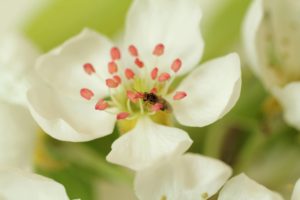
Pear fruit sawfly (Hoplocampa brevis) affects young pear fruitlets, causing them to drop. The adult is a small, fly-like wasp that is reddish-yellow in color. Females lay eggs inside flowers, and the hatched larva feeds exclusively within the developing pear for approximately six weeks from early to mid-spring. After this time, the insect goes into a dormant stage until the following spring.
The insect population size and amount of damage depends upon the previous year’s damage level, whether adult flight is synchronized with pear bloom, the level of fruit set, and overwintering conditions.
If the crop load is high, anecdotal evidence suggests that damage from pear sawfly will be “absorbed” by crop thinning, and therefore, intervention may not be necessary. If the crop load is light, the injury could cause a greater negative impact.
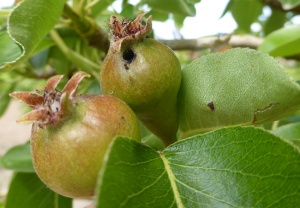
Treatment
- Utah pear growers have found success with a single insecticide treatment applied just before bloom.
- They reported that the use of horticultural oil (2% rate) mixed with a broad-spectrum insecticide (such as carbaryl, a pyrethroid, or diazinon) labeled for pear, have reduced losses.
- Do not spray too early, or the treatment will miss the arrival of the adults.
- Do not spray when bees are active.

